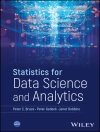A clear easy-to-read guide to presenting your message using
statistical data
Poor presentation of data is everywhere; basic principles are
forgotten or ignored. As a result, audiences are presented with
confusing tables and charts that do not make immediate sense. This
book is intended to be read by all who present data in any
form.
The author, a chartered statistician who has run many courses on
the subject of data presentation, presents numerous examples
alongside an explanation of how improvements can be made and basic
principles to adopt. He advocates following four key
‘C’ words in all messages: Clear, Concise, Correct and
Consistent. Following the principles in the book will lead to
clearer, simpler and easier to understand messages which can then
be assimilated faster. Anyone from student to researcher,
journalist to policy adviser, charity worker to government
statistician, will benefit from reading this book. More
importantly, it will also benefit the recipients of the presented
data.
‘Ed Swires-Hennessy, a recognised expert in the
presentation of statistics, explains and clearly describes a set of
‘principles’ of clear and objective statistical
communication. This book should be required reading for all those
who present statistics.’
Richard Laux, UK Statistics Authority
‘I think this is a fantastic book and hope everyone who
presents data or statistics makes time to read it
first.’
David Marder, Chief Media Adviser, Office for National
Statistics, UK
‘Ed’s book makes his tried-and-tested material
widely available to anyone concerned with understanding and
presenting data. It is full of interesting insights, is highly
practical and packed with sensible suggestions and nice ideas that
you immediately want to try out.’
Dr Shirley Coleman, Principal Statistician, Industrial
Statistics Research Unit, School of Mathematics and Statistics,
Newcastle University, UK
Tabela de Conteúdo
List of Tables vii
List of Figures ix
Introduction xiii
Preface xvii
Acknowledgements xix
1 Understanding number 1
1.1 Thousands separator 2
1.2 Decimal separator 3
1.3 Level of detail in comparisons 4
1.4 Justification of data 5
1.5 Basic rounding 7
1.6 Effective rounding 9
Notes 16
2 Tables 17
2.1 Position of totals in tables 17
2.2 What is a table? 19
2.3 Reference tables 19
2.4 Summary tables 22
2.5 How tables are read 24
2.6 Layout of data in tables 25
2.7 Capital letters for table titles and headings in tables 29
2.8 Use of bold typeface 30
2.9 Use of gridlines and other lines in tables 30
Notes 31
3 Charts (bar charts, histograms, pie charts, graphs) 33
3.1 How the user interprets charts 33
3.2 Written aims for charts 35
3.3 Scale definition and display 37
3.4 Difference between bar charts and histograms 49
3.5 Pie chart principles 51
3.6 Issues with pie charts 55
3.7 Graph principles 63
3.8 Issues with graphs 64
3.9 Pictogram principles 79
3.10 Comparative charts: Multiple pies, multiple bar charts, double scale graphs 82
3.11 Graphics 88
3.12 Three-dimensional charts 90
Notes 92
4 Numbers in text 93
4.1 Numbers written as text 94
4.1.1 Correct numbers 94
4.1.2 Clear numbers 94
4.1.3 Concise numbers 95
4.1.4 Consistent numbers 96
4.2 Ordering of data 97
4.3 Technical terms 98
4.4 Plain language 100
4.5 Emotive language 102
4.6 Key messages 103
Notes 105
5 Data presentation on the Internet 107
5.1 The early years 110
5.2 Statistics on CD-ROMs 113
5.3 Data on the Internet 116
5.4 Charts on the Internet 120
5.5 Text on the Internet 128
Notes 130
Sobre o autor
Ed Swires-Hennessy, Statistical Consultant, UK
Ed Swires-Hennessy was a government statistician until his retirement in 2010. His teaching on statistical presentation has continued and he currently delivers a one day course on Presenting Data for the Royal Statistical Society (RSS). In 2003 he was awarded the RSS JH West medal for outstanding contribution and influence on the dissemination of official statistics.












